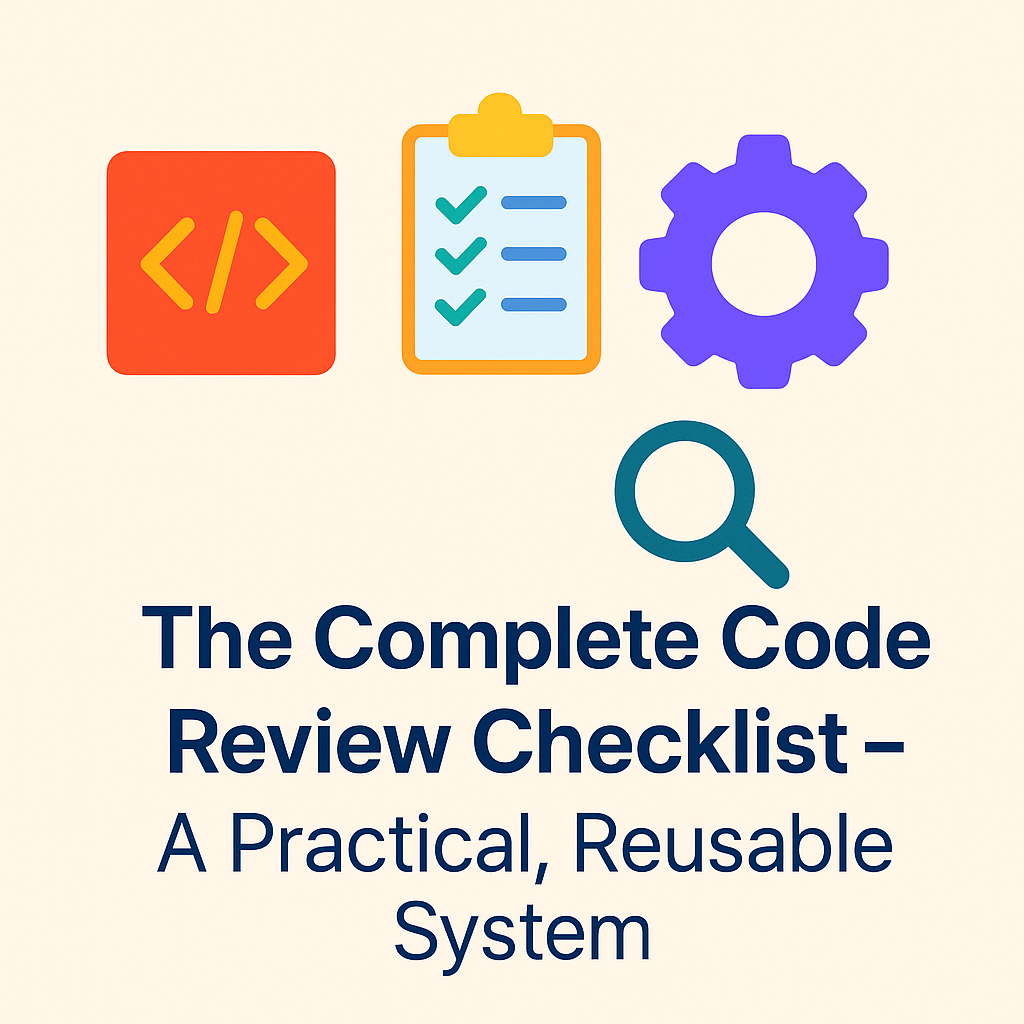🧰 The Complete Code Review Checklist – A Practical, Reusable System
“Good code is read more often than it is written.”
Here’s a systematic, concrete checklist you can reuse to review any repo — big or small, old or new — to judge, document, and improve its coding standards.

📌 Why a checklist?
A consistent review checklist helps you:
- Keep reviews objective and complete
- Catch subtle design, clarity, or security issues
- Build a shared team standard
- Learn faster when reading unknown codebases
This guide organizes code review into 8 core dimensions, with concrete examples and ideal patterns.
✅ 1. Project Structure & Organization
| What to look for | Why it matters | Ideal examples |
|---|---|---|
| Clear folder structure | Easier to navigate, scales as code grows | app/, lib/, spec/ |
| Descriptive file & class names | Find code faster | user_serializer.rb |
| Logical module boundaries | Decouples concerns | Payment::StripeClient vs PaymentService |
| README with install & usage | Helps newcomers | Install, usage, examples, env vars |
Tip: Small repos can skip complexity, but structure should still be intentional.
✏ 2. Code Clarity & Readability
| What to look for | Why | Ideal |
|---|---|---|
| Consistent formatting | Read faster | Indentation, line length |
| Meaningful names | Self-documenting | fetch_character vs fc |
| Small functions/classes | Easier to test & reuse | Methods <~20 LOC |
| Comments explaining why | Show intent | # we retry here because API occasionally fails |
Anti-pattern: Comments that explain what obvious code does.
📐 3. Design & Architecture
| What to look for | Why | Ideal |
|---|---|---|
| Clear separation of concerns | Flexibility & maintainability | HTTP logic vs parsing logic |
| Composition > inheritance | Avoid deep trees | Use modules or delegation |
| Encapsulation | Safer changes | Mark helpers private |
| Extensibility | Handle future features | Strategy pattern, small interfaces |
Red flags:
- God objects (>500 LOC classes)
- Methods doing unrelated things
🧰 4. Idiomatic Language Use
| What to look for | Why | Ideal |
|---|---|---|
| Language idioms & stdlib | Clearer, robust | Ruby: map, select, safe nav &. |
| Avoid reinventing the wheel | Fewer bugs | Use Time.parse instead of manual parsing |
| Consistent naming conventions | Predictable API | snake_case in Ruby |
🧪 5. Tests & Testability
| What to look for | Why | Ideal |
|---|---|---|
| Unit tests for core logic | Confidence to refactor | spec/ folder |
| Clear test descriptions | Understand failures | it "returns status 404 when not found" |
| Isolate external APIs | Faster, reliable | Mocks/stubs |
| Coverage for edge cases | Fewer surprises | Empty input, bad data |
Extra: Consider integration tests or contract tests for APIs.
📝 6. Documentation
| What to look for | Why | Ideal |
|---|---|---|
| README covers install, usage | Quick start | bundle install, npm start |
| Explains env vars & secrets | Easier onboarding | API_KEY=... |
| Code comments for tricky logic | Future maintainers | “why” this approach was chosen |
| Example requests/responses | Helps consumers | JSON snippet in README |
🔒 7. Security & Dependency Hygiene
| What to look for | Why | Ideal |
|---|---|---|
.gitignore secrets |
Prevent leaks | .env, config/secrets.yml |
| No hardcoded API keys | Safer deploys | Use ENV vars |
| Dependency versions pinned | Reproducible builds | Gemfile.lock, package-lock.json |
| Sanitize user input | Avoid exploits | Whitelisting, escaping |
Tip: Use tools like bundler-audit or npm audit.
⚙️ 8. Tooling & Consistency
| What to look for | Why | Ideal |
|---|---|---|
| Linter config | Enforce standards | .rubocop.yml, .eslintrc.js |
| Code formatter | Uniform style | Prettier, rufo |
| CI/CD config | Safer merges | .github/workflows/ |
| Hook pre-push checks | Catch errors early | overcommit, husky |
📊 Putting it all together: A repeatable system
Use this in practice:
- Clone the repo
-
Walk through each category, write notes:
- 👍 What’s good
- 🛠 What can improve
-
Prioritize fixes:
- High: security, test gaps
- Medium: large classes, naming
- Low: formatting tweaks
-
Share findings:
- As markdown (
CODE_REVIEW.md) - PR review comments
- Team retrospective
- As markdown (
🧪 Example summary (markdown)
# Code Review – Sample Project
## ✅ Project & Structure
✔ Clear `lib/`, `spec/` folders
✏ Consider adding usage section in README
## 📐 Code & Design
✔ Methods under 15 lines
✏ Rename `doWork` → `fetch_and_store_data`
## 🧪 Tests
✏ Add tests for empty response
## 🔒 Security
✔ No secrets committed
✏ Pin HTTP client gem to avoid breaking changes
## 🛠 Tooling
✏ Add `.rubocop.yml` for consistent style
📍 Conclusion
Reviewing code is about more than style — It’s about design, clarity, testability, security, and maintainability.
With this checklist:
- ✅ Reviews become systematic, thorough, and fair
- ✅ Teams share a language of quality
- ✅ Even solo projects stay clean over time
✏ Reuse it!
- 📄 Copy as
CODE_REVIEW.mdin every repo - ✅ Use as a Notion template
- 🧪 Adapt for different languages (Ruby, Python, JS, Go)